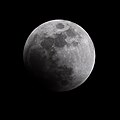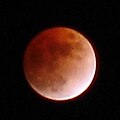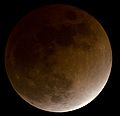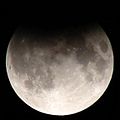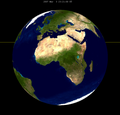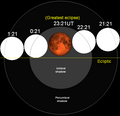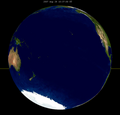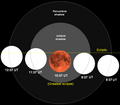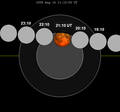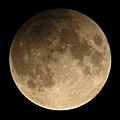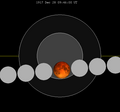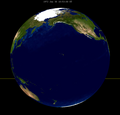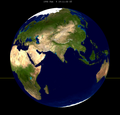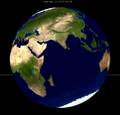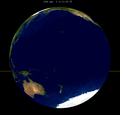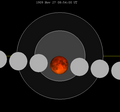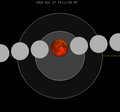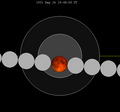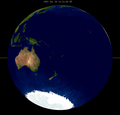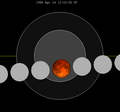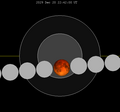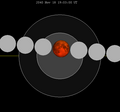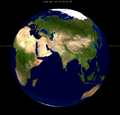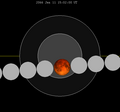Top Qs
Timeline
Chat
Perspective
February 2008 lunar eclipse
Total lunar eclipse of 20 February 2008 From Wikipedia, the free encyclopedia
Remove ads
A total lunar eclipse occurred at the Moon’s descending node of orbit on Thursday, February 21, 2008,[1] with an umbral magnitude of 1.1081. A lunar eclipse occurs when the Moon moves into the Earth's shadow, causing the Moon to be darkened. A total lunar eclipse occurs when the Moon's near side entirely passes into the Earth's umbral shadow. Unlike a solar eclipse, which can only be viewed from a relatively small area of the world, a lunar eclipse may be viewed from anywhere on the night side of Earth. A total lunar eclipse can last up to nearly two hours, while a total solar eclipse lasts only a few minutes at any given place, because the Moon's shadow is smaller. The Moon's apparent diameter was near the average diameter because it occurred 7.2 days after perigee (on February 13, 2008, at 20:00 UTC) and 6.8 days before apogee (on February 27, 2008, at 20:30 UTC).[2]
Remove ads
Visibility
The eclipse was completely visible over North and South America, west Africa, and western Europe, seen rising over much of the Pacific Ocean and setting over much of Africa, eastern Europe, and west, central, and south Asia.[3]
The bright star Regulus of Leo and the planet Saturn were prominent very near the Moon during the total eclipse portion. Shortly before the eclipse began, Regulus was occulted by the Moon in parts of the far Southern Atlantic Ocean and Antarctica.
 |
 Hourly motion shown right to left |
 The Moon's hourly motion across the Earth's shadow in the constellation of Leo. |
 Visibility map | ||
Remove ads
Timing
The Moon entered the penumbral shadow at 0:36 UTC, and the umbral shadow at 1:43. Totality lasted for 50 minutes, between 3:01 and 3:51. The Moon left the umbra shadow at 5:09 and left the penumbra shadow at 6:16.[4]
Remove ads
Images
 These simulated views of the Earth from the center of the Moon during the lunar eclipse show where the eclipse is visible on Earth. |

Gallery
Composites
 Eclipse observed from Sandim, Portugal. 41°02′22″N 8°30′50″W. |
 Eclipse observed from Regina, Saskatchewan. Each image is roughly taken 5 minutes apart. |
 Images taken in 3-5 minute Intervals - from Bradley, Illinois. |
 Eclipse observed from Halton Hills, Ontario. From 01:47 to 03:15 UTC, each image is roughly taken 5min apart. |
Eclipse observed from Winnipeg, Manitoba | |
Lunar eclipse observed from Burlington, Ontario | |
 Observed from Baltimore, Maryland, from 2:30 to 3:01 UTC. Lunar north is near left. | |
North America
Canada
- Eclipse Observed from Burlington, Ontario, at 2:00 UTC.
- Eclipse observed from Victoria, British Columbia, at 2:49 UTC. Lunar north is near top-left.
- Eclipse observed from Victoria, British Columbia at 2:56 UTC, just prior to total. Lunar north is near top-left.
- Eclipse observed from Salmon Arm, Canada at 3:11 UTC. Lunar north is near top-left.
- Eclipse observed from Burlington, Ontario at 4:05 UTC.
USA (west)
- Eclipse observed from Salem, Oregon. Lunar north is near top-left.
- Observed from Urbana, Illinois, at 3:06 UTC. Lunar north is near top-left.
- Observed from Boulder, Colorado, at 4:17 UTC. Lunar north is near top-left. Mare Humorum appears at bottom, Tycho's rays at bottom right.
USA (east)
- Moon observed from West Hartford, Connecticut, at 1:42 UTC. Lunar north is left.
- Eclipse observed from Philadelphia, Pennsylvania, at 2:49 UTC.
- Eclipse observed from Millersville, Pennsylvania, at 3:15 UTC. Lunar north is near left.
- Eclipse observed from West Hartford, Connecticut, at 3:17 UTC. Lunar north is near top-left.
- Eclipse observed from West Hartford, Connecticut, at 3:18 UTC. Lunar north is near top-left.
- Eclipse observed from Philadelphia, Pennsylvania at 3:36 UTC. Lunar north is top-left.
- Eclipse observed from Wellesley, Massachusetts, at 3:52 UTC
- Eclipse observed from Fredericksburg, Virginia, at 3:57 UTC.
South America
- Eclipse observed from São Joaquim, Brazil at 3:52 UTC.
Europe and Africa
- Eclipse observed from Rostock, Germany, at 1:50 UTC. Lunar north is near top.
- Eclipse observed from Sasolburg, South Africa - around 2:55 UTC. Lunar north is right.
- Eclipse observed from Prague, Czech Republic at 3:41 UTC
Remove ads
Eclipse details
Shown below is a table displaying details about this particular lunar eclipse. It describes various parameters pertaining to this eclipse.[6]
Remove ads
Eclipse season
This eclipse is part of an eclipse season, a period, roughly every six months, when eclipses occur. Only two (or occasionally three) eclipse seasons occur each year, and each season lasts about 35 days and repeats just short of six months (173 days) later; thus two full eclipse seasons always occur each year. Either two or three eclipses happen each eclipse season. In the sequence below, each eclipse is separated by a fortnight.
Remove ads
Related eclipses
Summarize
Perspective
Eclipses in 2008
- An annular solar eclipse on February 7.
- A total lunar eclipse on February 21.
- A total solar eclipse on August 1.
- A partial lunar eclipse on August 16.
Metonic
- Preceded by: Lunar eclipse of May 4, 2004
- Followed by: Lunar eclipse of December 10, 2011
Tzolkinex
- Preceded by: Lunar eclipse of January 9, 2001
- Followed by: Lunar eclipse of April 4, 2015
Half-Saros
- Preceded by: Solar eclipse of February 16, 1999
- Followed by: Solar eclipse of February 26, 2017
Tritos
- Preceded by: Lunar eclipse of March 24, 1997
- Followed by: Lunar eclipse of January 21, 2019
Lunar Saros 133
- Preceded by: Lunar eclipse of February 9, 1990
- Followed by: Lunar eclipse of March 3, 2026
Inex
- Preceded by: Lunar eclipse of March 13, 1979
- Followed by: Lunar eclipse of January 31, 2037
Triad
- Preceded by: Lunar eclipse of April 22, 1921
- Followed by: Lunar eclipse of December 21, 2094
Lunar eclipses of 2006–2009
This eclipse is a member of a semester series. An eclipse in a semester series of lunar eclipses repeats approximately every 177 days and 4 hours (a semester) at alternating nodes of the Moon's orbit.[7]
The lunar eclipses on July 7, 2009 (penumbral) and December 31, 2009 (partial) occur in the next lunar year eclipse set.
Metonic series
The Metonic cycle repeats nearly exactly every 19 years and represents a Saros cycle plus one lunar year. Because it occurs on the same calendar date, the Earth's shadow will in nearly the same location relative to the background stars.
Saros 133
This eclipse is a part of Saros series 133, repeating every 18 years, 11 days, and containing 71 events. The series started with a penumbral lunar eclipse on May 13, 1557. It contains partial eclipses from August 7, 1683 through December 17, 1899; total eclipses from December 28, 1917 through August 3, 2278; and a second set of partial eclipses from August 14, 2296 through March 11, 2639. The series ends at member 71 as a penumbral eclipse on June 29, 2819.
The longest duration of totality will be produced by member 35 at 101 minutes, 41 seconds on May 30, 2170. All eclipses in this series occur at the Moon’s descending node of orbit.[8]
Eclipses are tabulated in three columns; every third eclipse in the same column is one exeligmos apart, so they all cast shadows over approximately the same parts of the Earth.
Tritos series
This eclipse is a part of a tritos cycle, repeating at alternating nodes every 135 synodic months (≈ 3986.63 days, or 11 years minus 1 month). Their appearance and longitude are irregular due to a lack of synchronization with the anomalistic month (period of perigee), but groupings of 3 tritos cycles (≈ 33 years minus 3 months) come close (≈ 434.044 anomalistic months), so eclipses are similar in these groupings.
Inex series
This eclipse is a part of the long period inex cycle, repeating at alternating nodes, every 358 synodic months (≈ 10,571.95 days, or 29 years minus 20 days). Their appearance and longitude are irregular due to a lack of synchronization with the anomalistic month (period of perigee). However, groupings of 3 inex cycles (≈ 87 years minus 2 months) comes close (≈ 1,151.02 anomalistic months), so eclipses are similar in these groupings.
Half-Saros cycle
A lunar eclipse will be preceded and followed by solar eclipses by 9 years and 5.5 days (a half saros).[10] This lunar eclipse is related to two annular solar eclipses of Solar Saros 140.
| February 16, 1999 | February 26, 2017 |
|---|---|
 |
 |
Remove ads
See also
Notes
External links
Wikiwand - on
Seamless Wikipedia browsing. On steroids.
Remove ads










